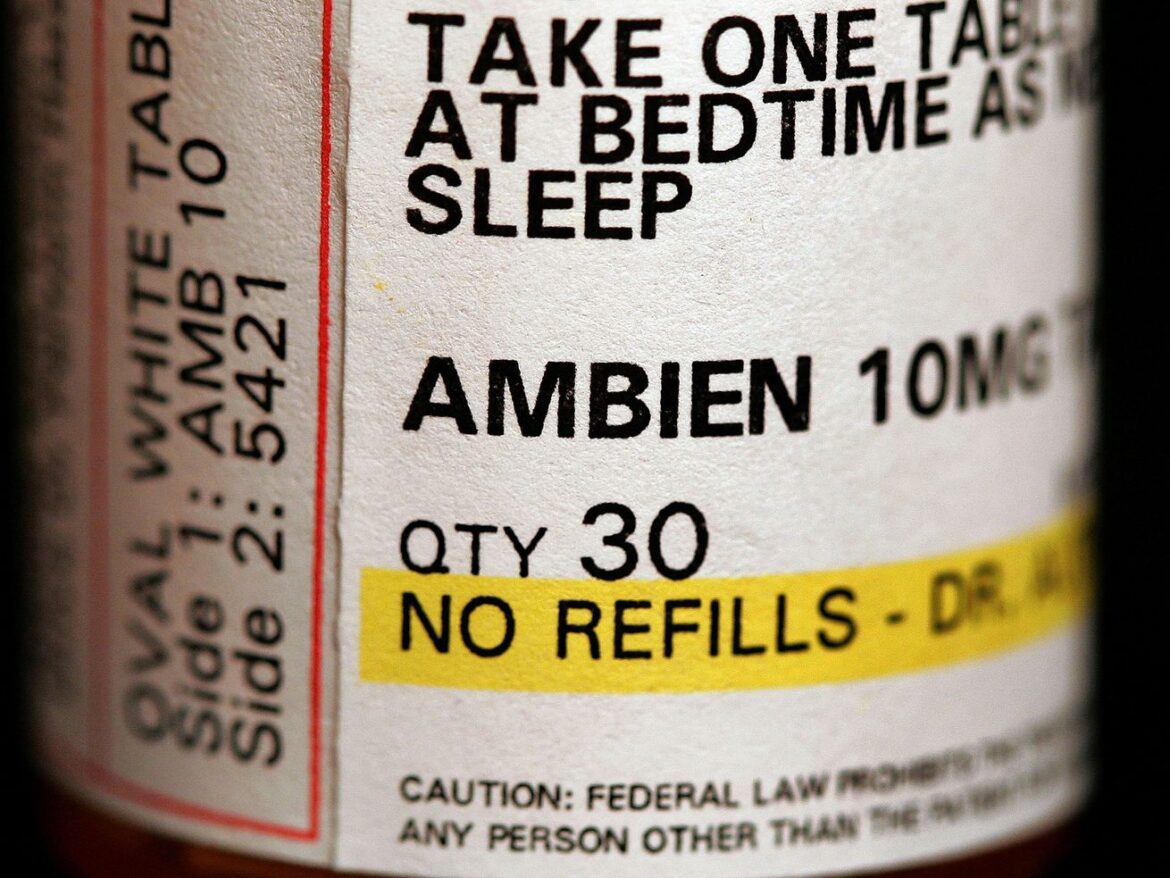The risks of sex-based drug dosing recommendations.
Zolpidem tartrate is infamous. It walks the street with many names: “A-minus,” “zombie pills,” “no-go pills.” It has been blamed for a range of strange and disastrous incidents in the news over the years, including Roseanne Barr’s racist tweeting in 2018 and Tiger Woods’s terrible car accident in 2021. But you probably know zolpidem tartrate best by its brand moniker: Ambien, which hit the markets in 1992.
Ambien, a drug commonly prescribed as a short-term solution for people experiencing insomnia, is famous not only for its association with celebrity fiascos and faux pas, but also for being the first and only drug sold under an FDA-mandated sex-specific dosing regime in the United States. In a landmark 2013 decision, the Food and Drug Administration recommended that women take half the dose of men, citing new data on women’s higher risk for next-day cognitive impairment that posed dangers for activities like driving.
This dosing regime put sex differences on the scientific and regulatory radar. In the eyes of many biomedical scientists, Ambien became a “textbook example” of how neglecting sex as a variable leads to disastrous consequences. This coincided with increasing recognition of the medical establishment’s long history of assuming the white male body as default (women and minority groups weren’t legally required to be included in clinical trials until the 1993 NIH Revitalization Act). It also aligned with a growing prioritization of women’s health as its own area deserving of funding and resources. When the FDA came out with its recommendation to halve Ambien dosage for women in 2013, biomedical scientists from many fields took it as an urgent warning.
In a 60 Minutes segment, journalist Lesley Stahl sat down with Larry Cahill, neuroscientist and professor at the University of California Irvine, about the importance of the decision. “If science got Ambien so wrong, does that tell you we really need to go back and review —” “Yes,” Cahill interjected. “Everything?” Stahl continued with her eyebrows raised. “Pretty much everything,” Cahill insisted.
For many researchers like Cahill, Ambien presented the perfect example to motivate wider changes, specifically the National Institutes of Health’s 2016 Sex as a Biological Variable policy, which mandated the incorporation of male and female sexes into the analyses of all federally funded, model organism preclinical research.
But is Ambien really a textbook example of sex differences? As researchers at the Harvard GenderSci Lab, an interdisciplinary lab that studies the methodologies, empirical claims, and sociopolitical context of studies of gender and sex differences in biomedicine (including areas like preclinical science, Covid-19, and sperm count science), we know that this area of science is deeply contested, with a history of bias and overstatement of sex differences tinged with stereotypes. We think about questions such as: How do scientists, the government, and the public(s) determine what constitutes a fact about differences between the sexes? What is the role of law and policy in validating the authority of scientific claims about sex and gender? And, conversely, how do policies and interventions take up such claims? We track how ideas about the nature of gender categories transform as they traverse domains as varied as laboratories, courtrooms, and business pitches.
Our collaborative team of scholars analyzed the scientific and public life of Ambien’s sex-based dosing claims, the results of which were recently published in the journal Social Studies of Science. We show that what seems a straightforward fact about pharmacological sex differences is not so simple, and what was widely hailed as a victory for women’s health and equity is not obviously so. Troublingly, this Ambien “fact” might actually be encouraging imprecise science and reinforcing a set of harmful assumptions about binary sex.
Unpacking the FDA decision process
How did the FDA’s 2013 recommendation come about? The agency’s regulatory approval process for pharmaceuticals is notoriously intense. Regulatory decision-makers incorporate many forms of scientific evidence, and they also make judgment calls about how to weigh efficacy and risk, which metrics to use, and when to exercise extra caution.
When Ambien was originally approved in 1992, the recommended dosing was sex-neutral. That changed in 2011 during the approval of a new formulation of Ambien called Intermezzo. As the name suggests, Intermezzo was supposed to be taken in the middle of the night, for patients who woke up and couldn’t fall back asleep. Taking a sleep aid in the dead of night left less time for the drug to be metabolized before patients woke up, leaving them potentially drowsy and dangerous drivers the next morning. Because of this, the FDA was especially worried about both how quickly patients metabolized the drug and the real-time effects of the new formulation.
This resulted in a drawn-out approval process for Intermezzo in which the FDA demanded that the drug company perform a study to examine the effects of Intermezzo on drivers at three and four hours post-dose, reflecting their broader concern about the safety of sleep aids. This study did not find that Intermezzo interfered with driving four hours after dosing. But the FDA remained worried about high levels of zolpidem in the bloodstream at this time interval, and pushed the drug company to find a way to lower morning drug levels in the blood for all patients below a cutoff point associated with driving impairment at three hours post-dose. Because other studies showed that female patients metabolized the drug more slowly than male patients, the drug company acquiesced by lowering the dose for female patients to half of that for males.
Importantly, the Intermezzo evaluation wasn’t based on direct evidence that slower clearance rates caused driving impairment. Furthermore, when adjusted for weight, sex differences in clearance rates themselves were reduced or even, in one case, reversed. (However, the FDA rejected this adjustment because it found that weight alone did not statistically predict clearance rates.) Ultimately, sex was a convenient way to reanalyze existing data, saving Intermezzo’s manufacturer, Transcept, from another cycle of regulatory scrutiny and from having to perform additional studies.
Shortly after this decision, the FDA used the zolpidem blood level cutoff from the Intermezzo approval process to reanalyze data for other formulations of Ambien. On the basis of the Intermezzo review, together with additional reanalysis evidence that high levels of zolpidem correlated with next-day cognitive impairment, the FDA extended this sex-based dosing scheme to all formulations, including those meant to be taken before bed.
A sticky and compelling sex difference “fact”
References to the FDA’s sex-based dosing recommendation rapidly populated teaching materials for scientists, academic papers, and popular media like the New York Times, TED Radio Hour, and ABC News. Many scientists underscored Ambien as a canary warning of the wider problem of preclinical and clinical science’s neglect of sex: Who knows how many other biological sex differences in drugs we remain ignorant of, because female biology is ignored in research? In the words of Janine Clayton, director for the NIH Office for Women’s Health, Ambien was “just the tip of the iceberg.”
In academic papers, Ambien served as a touchstone for researchers advocating for application of the NIH’s Sex as a Biological Variable policy across fields as diverse as neuropsychopharmacology, surgery, and preclinical studies of alcoholism and neurodegenerative diseases. These researchers used Ambien to argue that scientists need to incorporate sex as a variable in their statistical analyses, disaggregate by male/female groups, and look for differences in sex-based biology. Non-scientific bodies took notice, too. The Bill and Melinda Gates Foundation made Ambien a case study in its “Gender Equality Toolbox” designed to inform grant funding bodies, and McKinsey cited the drug as a harbinger of sex-based health care and treatment, and their ripe investment opportunities.
In these literatures, the sex difference fact was conveyed as the following: Female patients experience higher rates of adverse reactions to zolpidem due to their slower metabolism of the drug, and the FDA recommendation, long overdue, corrects for this by halving the dose. This Ambien story, now common parlance in biomedical literature, oversimplifies both the FDA evidence and state of the research.
A fact detached from the scientific debate
Sex-based dosing for Ambien reflects neither scientific nor international regulatory consensus. In fact, since Ambien’s approval in the 1990s, researchers have studied the effects of sex, age, and race/ethnicity on zolpidem tartrate. Although they found that women generally had slower clearance (metabolism) rates of zolpidem than men, there was much individual variability, and adjusting for body weight in the analysis reduced much of the observed sex difference, often rendering it statistically insignificant. In one study, older men actually had the slowest clearance rates (and the FDA has suggested that older people of all genders are at higher risk of cognitive impairment).
Although the FDA was partially motivated to regulate on the basis of its internal reanalysis data, there has been no clear scientific consensus that slower clearance rates are primarily responsible for sex differences in impaired driving or auto accidents. Moreover, if adverse effects from high zolpidem blood levels are a concern for women, we should also worry about the men who have higher zolpidem levels in the morning.
In other words, if the goal of the FDA recommendation was to reduce cognitive impairment and driving accidents for everyone, it’s not clear that halving the dose for women achieved that. Factors like taking multiple concurrent drugs and interactions with age and body weight might also be salient. As we describe in greater detail in the journal Social Studies of Science, like all regulatory policies, the FDA decision reflected a confluence of scientific and political judgment in the face of uncertainty, including a choice to minimize bloodstream levels and rely on sex categories to manage the general risk of automobile accidents.
Pharmacology and sleep medicine researchers have since challenged the reasoning behind the FDA’s 2013 recommendation, suggesting that it was missing “concrete evidence” and might have caused undermedication for many women with sleep disorders, which poses its own public health risk. Significantly, aside from Canada and the United States, no other national drug agency has implemented sex-specific dosing for zolpidem.
In spite of this, Ambien has become a touchstone example for the public and those advocating for sex-specific medicine in the name of women’s health. As elaborated in our paper, our team found that academic and public-facing references to zolpidem sex differences often misrepresent the evidence. For instance, researchers have mistakenly suggested that emergency room visits and car accidents were primarily responsible for the FDA’s decision (rather than reanalyses of existing data and driving studies), or that zolpidem was removed from the market (only the label’s dosing language was changed). Authors almost never mention the possible relevance of body weight and the FDA’s concurrent suggestion that men also start off with half doses. Some authors cite publications without original data or which do not support their claim, and other authors don’t provide a citation at all, treating zolpidem’s sex difference as an established, canonical fact, one with regulators’ and policymakers’ seal of approval. While it is not uncommon for scientists to disagree about regulatory decisions, the Ambien claim has miraculously transcended both ongoing disagreement and the complexities of its original context.
Faulty facts and their fallout
It matters when a faulty sex-difference “fact” persists and circulates unquestioned. Once such a “fact” is out in the world, it can be very difficult to unseat or revise. This phenomenon has been documented in the case of misconceptions about spinach’s high iron content, as well as more loaded claims like testosterone’s association with violence. Scholars have termed these “academic urban legends” and “zombie facts” (which cannot be killed no matter how many times they are refuted).
How can we make sense of the uptake and proliferation of claims about sex differences in Ambien? Why is it so sticky, while other textbook facts are being knocked down? For one, the FDA’s decision carried the weight and credibility of a federal regulatory authority. Even though the decision involved a contextual assessment to exercise caution and use sex-based dosage to lower morning blood levels, that nuance was lost as it was communicated to diverse audiences and used in different rhetorical settings. And once it was regarded as a “textbook” fact, the claim no longer received as much scrutiny.
In addition, the story of Ambien sex differences strongly aligned with the platforms of existing advocacy groups. Over the past 25 years, women’s health advocates have elevated the problem of androcentrism and bias in medical research, emphasizing sex differences. Ambien seems like a clean, “perfect example” of women’s intrinsic biological difference from men, validating something that people often already feel to be true and what women’s health advocates have often argued: that sex differences are ubiquitous and clinically relevant. As Stahl commented on CBS after the 60 Minutes special: “Now we are learning that [men and women] are pervasively different at every level. Our lungs are different, our skin is different, our cells are different.”
This way of looking at gender and sex — as two distinct types carving up the human population and producing distinctions at every biological level that explain health disparities — is what scholars call binary biological sex essentialism, and it has serious limitations.
Numerous scientific studies show that a sex binary of male and female just doesn’t work to explain the range of variability in humans, animals, and cellular mechanisms. It also privileges intrinsic biological differences as an explanation over social and structural factors or interactions between the environment and biology. Ultimately, this makes science and medicine worse for everyone, including people who don’t fall neatly onto one side of the supposed binary — trans and gender-expansive individuals, people with intersex conditions, and anyone who departs from the average body weight or testosterone/estrogen level for their sex.
Certainly, sex-related variables like hormones, gonadal physiology, and chromosomes are important to account for in scientific research such as drug reactions. But if the aim is rigorous science, we need to discard the simplistic notion of sex as merely male or female, stop using sex as a coarse proxy for other mechanistically relevant features like body weight or hormones, and examine interactions between age, other drugs taken, lifetime stress levels, and other social variables to develop medicines that work for everyone, not just the imagined average “male” or “female” patient.
Sex-difference claims can also reify culturally embedded notions of two discrete, intrinsically different sexes. Although science that applies a binary sex framework has been championed as a win for women’s health, bad-faith actors have used a similar framework to support trans-exclusionary agendas. Sex-essentialist science has been exploited by those seeking to invalidate trans identities by appealing to the alleged naturalness of the sex binary, whether an XX/XY binary in chromosomes or a penis-vulva binary in genital anatomy. Many anti-trans platforms draw specifically on language from research advancing binary sex differences (e.g., in sports, federal laws about public bathroom access, and federal level health services), thereby claiming that scientific legitimacy and biological reality are on their side.
The consequences are grave and imminent: At the time of writing, 563 anti-trans bills have been proposed in 49 states, with 80 having already passed, in a historic legislative assault on the existence of trans people, particularly via restrictions on gender-affirming health care for trans youth. While many researchers share a laudable vision of sex and gender equity, sex essentialist approaches may concretize an oversimplified understanding of sex that runs counter to this goal, particularly in this political context.
Ambien isn’t the cautionary tale we think
Cahill was right in a sense: Ambien provides a cautionary tale. Rather than offering a paragon example of biological differences between men and women, it instead illustrates how a distorted fact about pharmaceutical sex differences became common knowledge, as well as how hype, advocacy platforms, and assumed authority enabled its proliferation and misrepresentation. Sex difference facts are notoriously sticky, and they powerfully shape the concepts and frameworks in experiments, funding agendas, and policy justifications — so we need to make sure we get them right.
To do that, we need a science that embraces the complexity of sex-related variables and their interaction with other biological and social factors in producing human variation in drug response. Comparing men and women is not enough, and we need caution and awareness about the potential bias and overstatement of such claims.
Before appealing to a textbook sex difference claim, it might be best to sleep on it.



